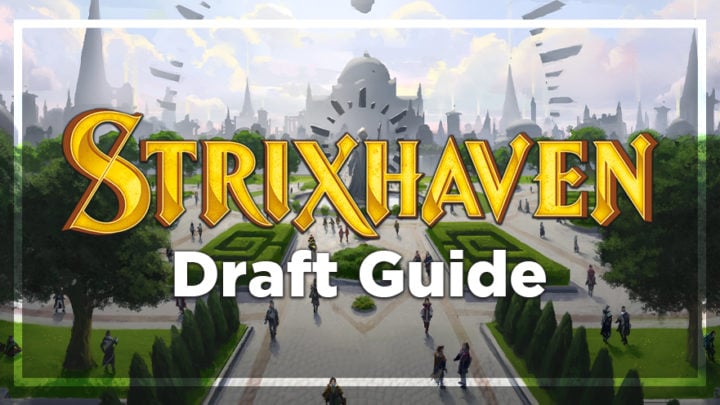If you want to draft Strixhaven, get ready to go back to school. This new set doesn’t concern itself with enabling a “vanilla” Magic experience — instead, it feels like drafting someone’s highly specialized Cube. Unprecedented mechanics like learn, an unusual set makeup, and a swathe of high-impact bombs from both the set proper and the Mystical Archive cards all challenge the norms of Limited card evaluation and gameplay.
When I started drafting Strixhaven, I gave up quick losses with what felt like great decks. Before I could bounce back to my usual rank and win rate, I had to learn the hard way about the format’s unique demands; the school rules, if you will. Let me (and this guide) save you the trouble (and gems) of learning the hard way — your very own Limited cheat sheet!
WELCOME TO STRIXHAVEN 101
The quickest way to appreciate the demands of drafting Strixhaven is to look at the set makeup. First off, this set is about instants and sorceries; it has fewer creatures at common and uncommon compared to any modern set. The difference isn’t huge, but its impact is exacerbated by a few other factors. For instance, an above-average number of those instants and sorceries require you to target your own creatures — pump spells, fight spells, defensive options, and even some utility effects that will turn to bricks if you have an empty board. And WotC didn’t make it easy to keep creatures in play, either, with tons of powerful removal available to every deck and color.
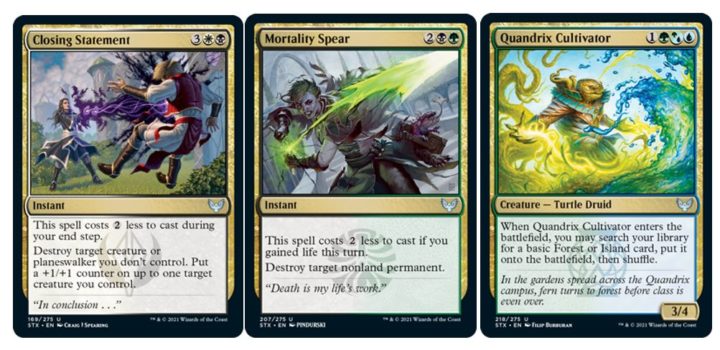
But the real hurdle to drafting playable decks when you start at Strixhaven is the astonishing gold card count. This set has 90 multicolored spells: twice as many as Kaldheim, more than quadruple Zendikar Rising, and more than any Ravnica set in history! What’s more, many of these extra gold cards are in the common and uncommon creature slots. Strixhaven only has seven fewer non-rare creatures than Kaldheim, for instance; the viking set was already below the average for such cards. But if you filter out multicolored creatures, the gap balloons to 27! And it’s even bigger compared to other recent sets like Zendikar Rising, Theros Beyond Death and Throne of Eldraine.
So in a set where creatures are already thin on the ground, a significant portion of the ones you crack will be essentially locked off to you by the middle of the draft. Three-color decks can be found in the “wedge” color combinations that combine two Colleges, but it’s quite difficult and risky. There is little fixing in the set, even in green, and the tempo loss is a very real cost — because this is a set which emphasizes tempo through every part of its design.
DON’T COMMIT TO COLLEGE TOO SOON
While every Strixhaven deck will eventually move towards a specific College, it is hugely important to keep open through most first packs. The lack of fixing and high rate of gold cards means you can easily get “trapped” in a College that’s heavily cut and end up without creatures or removal — something I’d never really experienced prior to this set. If you can headhunt playables of a single color early on, you’re able to pivot into either College of that color by pack two. Going heavy on the “shared color” also gives you best odds of a successful splash, as you’ll be able to keep both College’s hybrid mana costs within your reach.

Since getting ahead on board early is the biggest edge you can take for this format, this means monocolor two-drops are prime pack one material — they set you up to take the cool pump spells and tricks later on. Removal is even higher priority, in particular the three-mana-or-less options. Expel and Bury in Books might slip by you as second-rate removal, but what’s important is that they let you start taking creatures off the board ASAP. Waiting an extra turn to start trading cards means you’re now steadily taking hits from that first creature, and it’s surprisingly hard to turn the corner. Again, I recommend taking “too many” such spells in your first drafts and seeing if that actually feels like a mistake once you play.
Other than removal and learn spells/Lessons (which should all be highly prioritized), good monocolor commons and uncommons to take early include:
WHITE
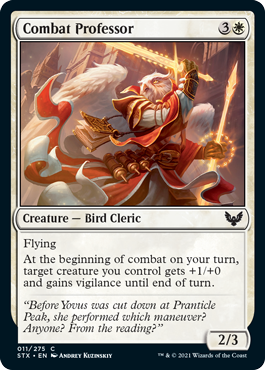
Combat Professor, Pilgrim of the Ages, Ageless Guardian, Eager First-Year, Stonebinder’s Familiar, Lorehold Pledgemage, Silverquill Pledgemage
RED
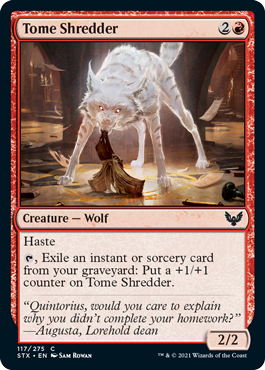
Blood Age General, Illustrious Historian, Ardent Dustspeaker, Tome Shredder, Lorehold Pledgemage
GREEN
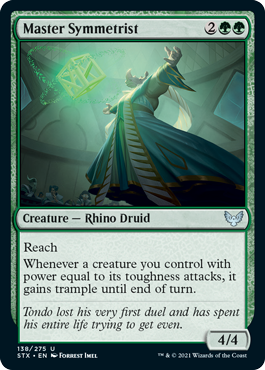
Master Symmetrist, Professor of Zoomancy, Emergent Sequence, Overgrown Arch, Scurrid Colony, Spined Karok, Witherbloom Pledgemage
BLACK
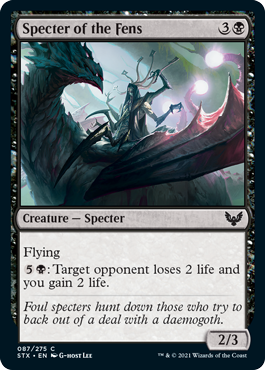
Leech Fanatic, Go Blank, Specter of the Fens, Promising Duskmage, Brackish Trudge, Witherbloom Pledgemage, Silverquill Pledgemage
BLUE

Reject, Frost Trickster, Burrog Befuddler, Serpentine Curve, Soothsayer Adept, Mentor’s Guidance, Wormhole Serpent, Prismari Pledgemage, Quandrix Pledgemage
GOOD TIME MANAGEMENT MAKES GOOD STUDENTS
Every strong Strixhaven deck tends to fall into two categories: tempo or control. Every College color pair has a duality to its cards, letting it play a fast or slow game in equal measure. Obviously, within a deck, you can pivot between roles a little depending on your draw, but you will want to prioritize different cards even within your College based on what you’re seeing and how you want to play.
In my experience, only the most high-roll pools where you get tons of removal and bombs in-color can reliably take the slow path. If you’re not feeling cocky a few picks into pack two, start looking for a solid early creature count. The surplus of removal and card advantage from learn spells may make this feel unnecessary, but you’ve been warned! You really don’t want to fall into the midrange trap for this set, if my results are anything to go by.
The possible exceptions to this “tempo-as-default” mindset are Quandrix and Prismari, but even here, I would take caution, as their common and uncommon late-game cards are highly contested.
YOUR O-WEEK GUIDE TO STRIXHAVEN
I feel like the mindset I’ve described so far is more important to success in Strixhaven than specific card or color rankings, but while you’re here, you might as well cheat off my notes for playing fast and slow in each College — plus a few outlier decks you might try!
SILVERQUILL
My most successful College by some margin thus far, and my most played. It’s perhaps inevitable that prioritizing removal will land you here more often than not, since the white-black combination has a staggering number of unconditional kill spells. Killian, Ink Duelist is an incredible signal you can move into this deck if you see it, and informs how both fast and slow Silverquill builds play.
Tempo drafts will leverage their share of removal (which Killian discounts) to keep good blocks off the table or punish attempts to race with pump spells. I prefer to stack up magecraft creatures rather than play much pump of my own, but the cards that grant permanent +1/+1 counters can be very good in moderation. The slower Silverquill decks also tend to have high flyer counts. Combat Professor is among the strongest commons of the set, and getting more than one is a good sign you can pick up Owlin Shieldmage and extra Inkling cards to bolster it while your two-drops and Spiteful Squad clog up the ground.
Inklings in general might be the most consistently useful “mascot” token, and especially so with the college’s hybrid bomb Dramatic Finale. But if you can grab one early, try shooting for a base-black build with a splash of green. Finale isn’t something you need to play on curve, Pests are most efficient at using the anthem effect, and Witherbloom’s creature-based stalling prowess gives the powerful enchantment more time to take over games.
But without access to that rare, I actually find the more natural splash from Silverquill to be red. This unlocks a devastating critical mass of “prowess” cards, including both Pledgemages, which can snuff out games at lightning speed. You can secure a surprising amount of fixing for little loss of pace thanks to Campus Guide, Treasure from Sudden Breakthrough or Storm-Kiln Artist, and a learn spell + Environmental Sciences!
LOREHOLD
Apologies to those who dislike red-white draft dominance; I’ve found Lorehold to be one of the most powerful Colleges so far, and definitely the most contested. The “Spirit tribal” theme is quite real, and emerges seamlessly from Lorehold’s natural curve of aggressive two- and three-drops. Their removal is another source of their popularity, with super-efficient options up and down the curve. When you consider tricks like Enthusiastic Study, Sudden Breakthrough and Make Your Mark — all of which leave a bit extra behind — red-white has nearly twice as many ways to force trades as other Colleges.
The interaction (or just the threat of it!) ensures that your first few creatures will be chiseling away life turn after turn as you pick off or pump through blockers. And when half those spells bring in token reinforcements from the sideboard, the tempo train can be impossible to stop. Special shoutouts to Ageless Guardian — given the number of ways to pump its power and the importance of a survivable blocker in worst-case draws, I’ve rarely been happier to draft a 1/4.
Slower Lorehold decks are less common, both due to the College’s aggro prowess and the tendency for late-game red decks to skew Prismari instead. Instead of putting the pedal to the floor, these Lorehold lists use their early lead to freeze the enemy in a board stall, then grind them out with value engines. (Quintorius, Field Historian, Lorehold Excavation, Fuming Effigy, Dueling Coach and Lorehold Apprentice are all great options.) You can also simply upscale the tempo plan: flyers, inklings and Relic Sloth will keep opponents scrambling to have enough blockers, and then one or more Pigment Storms can open up the lethal attack.
QUANDRIX
A tricky College to navigate, in my experience. Many of Quandrix’s highest-ceiling cards have disastrous low floors, or ask you to fall behind on board for some ramp payoff later on. To be blunt, I’ve found that cardinal sin against tempo to rarely be worth it unless you’re already winning. The ramp also plays poorly with blue’s bounce, tap, and tuck interaction; if you’re only using those to buy time without shifting combat math in your favor, the inefficiency of this “active stalling” will tie up the mana advantage you gain. The surfeit of hard removal in the set just makes it harder to have ramp pay off; even the mighty Bookwurm is often exiled the moment it arrives.
Dire warnings aside, Quandrix is still extremely powerful — just with a more even-handed, curve-based approach. Green is the only color with big enough bodies to support something resembling traditional midrange, which this College can ramp into or supplement with its scalable Fractal tokens. The blue tempo interaction also shines best when paired with large green boards — Master Symmetrist is the Quandrix “mythic uncommon,” and it can set up unstoppable lethals as you bounce away larger blockers and trample through chumps. Finally, you can sprinkle in a couple of the better ramp options: Emergent Sequence, Quandrix Cultivator and Field Trip (fetching Fractal Summoning) all produce bodies while skipping you up the curve and enabling either blue Pledgemage.
If you are determined to play the cool card draw engines scattered across Quandrix colors — and they’re often left in the packs — I would strongly suggest drafting Temur. This is the best true three-color deck in the set, with the Treasure tokens from Prismari for fixing and card draw to find both lands and payoffs. But most importantly, access to red removal patches up the flaw I mentioned earlier: killing early attackers will actually slow the game down enough for cards like Eureka Moment, Serpentine Curve and Bookwurm to shine, not to mention the huge Prismari sorceries. Make sure to take a lot of lessons when you draft like this; Environmental Sciences is strong fixing, and a stream of token summonings from the side will clog the board while enhancing your “spells matter” payoffs.
PRISMARI
I’ve only played a Prismari deck once, and their gold cards are virtually never in packs in my Arena Draft pods. As with Lorehold, if you want to play a red deck, it’ll take a bit of luck and strong early signaling, at least until the online Draft metagame evolves a little. But at least the payoffs are there, and Prismari has some terrific options on both the fast and slow end of the scale. It also has the best fixing for splashes, oddly enough, thanks to the College’s affinity for Treasure tokens.
Prismari aggression is simple enough: early red creatures and removal set the pace, while blue can keep you flush with cards, buy you an extra open swing, or just go over the top with evasive finishers. Maelstrom Muse and Prismari Apprentice in particular are rightly sought-after. The value of these magecraft creatures is inflated by the steady, easily-established chains of spells: start with a learn card, cast Introduction to Prophecy, then cast more learn spells, then Elemental Summoning…
Better yet, Prismari has the cream of the crop when it comes to learn spells. Enthusiastic Study, Divide by Zero and Igneous Inspiration are top-tier interactive spells, while First Day of Class, Arcane Subtraction and Academic Dispute are only slightly worse off in aggressive decks. By the time you reach the five-mana mark, a single Pigment Storm or Treasure-assisted Elemental Masterpiece will be all you need to finish things off.
Extending this magecraft-aggro build into Jeskai is just as powerful as the Mardu build I mentioned, albeit less consistent, as U/R lacks the consistent creature quality of W/B or R/W. The slower Prismari builds are even more likely to feature a splash, and Temur colors provide an ideal mix of ramp, fixing, removal, and big-mana payoffs. I’m sure it’s also possible to splash another color if you get enough game-crashing bombs to justify it; such is the power of Treasure and Environmental Sciences backed up by burn.
WITHERBLOOM
The final College seems to be the most misunderstood, at least judging by the frequency I find it open in Draft pods. This environment is quite hostile to Witherbloom’s lifegain and sacrifice synergies; even if you can draw the right mix of enablers and payoffs, a single piece of removal sets you back to the stone age. The fact that many of these synergy cards are complete bricks without a board — Plumb the Forbidden, Tend the Pests, Infuse with Vitality, Essence Infusion, Fortifying Draught, even green’s fight spells — means you can easily draft a truly unplayable Witherbloom deck if you aren’t careful.
Another pitfall to consider here: while Witherbloom can easily clog the ground up and stall, the College lacks a consistent, built-in way to end long games. Unfortunately, black has next to no worthwhile bodies above two mana. Specter of the Fens can be a role-player, but Novice Dissector is straight-up the worst creature in the set, with Tenured Inkcaster close behind. Along with a lack of flyers and direct damage, this makes it tricky for Witherbloom to replicate the UGx midrange plan, even with access to strong removal.
As such, slow Witherbloom decks tend to be overwhelmingly defined by their rares. With an early pick like Dramatic Finale, Harness Infinity or Professor Onyx, you can set yourself up to stall comfortably. Otherwise, you’ll need to take a different approach.
Luckily, Witherbloom tempo is among the most fun and powerful decks you can draft in Strixhaven — it’s just very specific, requiring a clear run on the College’s cheap, powerful gold cards. Lifegain synergies actually work well in a tempo deck, since they make it impossible for rival aggression to race you. And if they try to block, the potent all-common backbone of Blood Researcher, Moldering Karok and Infuse with Vitality will reliably blow them out. Rather than lots of junky black creatures, playing every removal spell possible will make blocking the Researchers impossible most of the time. Special mention goes to the green fight/bite spells for the extra lifelink synergy.
Most of Witherbloom’s cards are at their best here. Witherbloom Pledgemage breaks board stalls with its own body and easy life trigger, while Witherbloom Apprentice, Tenured Inkcaster and Dina, Soul Steeper also add value. Simply chaining Hunt for Specimens into Pest Summoning shuts down ground aggression, while the life buffer lets you naturally reach eight lands for Bookwurm and Scurrid Colony. Of course, Leech Fanatic and Silverquill Pledgemage are absolutely vital as cheap, efficient lifelinkers. This is an archetype with a more obvious fail case, but between the solid common payoffs and excellent rare ones, I think every player should try it out once they’re settled into Strixhaven.
ONE FINAL LESSON
Before we wrap up our study session, I want to address one of the more obvious oddities of Strixhaven: the learn mechanic, which adds sideboard considerations even to Best of One drafts. The easiest adjustment you can make is to prioritize these spells highly; every single learn card is playable-to-good, assuming you grab one or more of the ubiquitous token-making Lessons. Even the non-token Lessons are largely good: Environmental Sciences helps reach high land counts or fix your colors, Expanded Anatomy can flip board stalls and damage races, and Introduction to Annihilation can be a guaranteed deathblow when you’re ahead or an effective stall when you’re behind.

The gameplay impact of stuffing every deck with “free” extra spells is significant — card advantage is somewhat less important than you’d expect in Limited. I’ve come back plenty of times from spots where I was behind on hand size and board position, because the extra value from Lessons (and accompanying magecraft triggers) did the work of several cards.
We’ve previously defined tempo as “mana advantage,” the opposite strategic angle to card advantage. By making it harder to run opponents out of cards, Lessons become another factor emphasizing the primacy of tempo in Strixhaven Draft games. When players are trading card-for-card all day long, the person with the on-board edge will slowly — or quickly! — run their opponent out of life.
VALE, DRAFT GUIDE GRADUATES!
Well, that’s as much as I dare say about Strixhaven Limited — at least for now. There’s certainly more left to discuss. The impact of the many powerful Mystical Archive spells, the fascinating position of defensive spells like Professor’s Warning, Beaming Defiance and Snakeskin Veil… and I’m sure you’ve noticed how little we’re discussed the set’s rares and mythics!
That’s not by accident — while many of those rares are powerful bombs, they’re mostly just upgrades for another card in your color, with only a few requiring much strategic adjustment to pay off. So I hope that by focusing on the baseline strategies of each College, you’ll now be able to consistently assemble winning decks that your on-color rares can push over the top. To me, that’s one of the hallmarks of a good Draft set, and I’m definitely high on Strixhaven Limited so far. I hope that you find college life as edifying as I have!

Tom’s fate was sealed in 7th grade when his friend lent him a pile of commons to play Magic. He quickly picked up Boros and Orzhov decks in Ravnica block and has remained a staunch white magician ever since. A fan of all Constructed formats, he enjoys studying the history of the tournament meta. He specializes in midrange decks, especially Death & Taxes and Martyr Proc. One day, he swears he will win an MCQ with Evershrike. Ask him how at @AWanderingBard, or watch him stream Magic at twitch.tv/TheWanderingBard.

